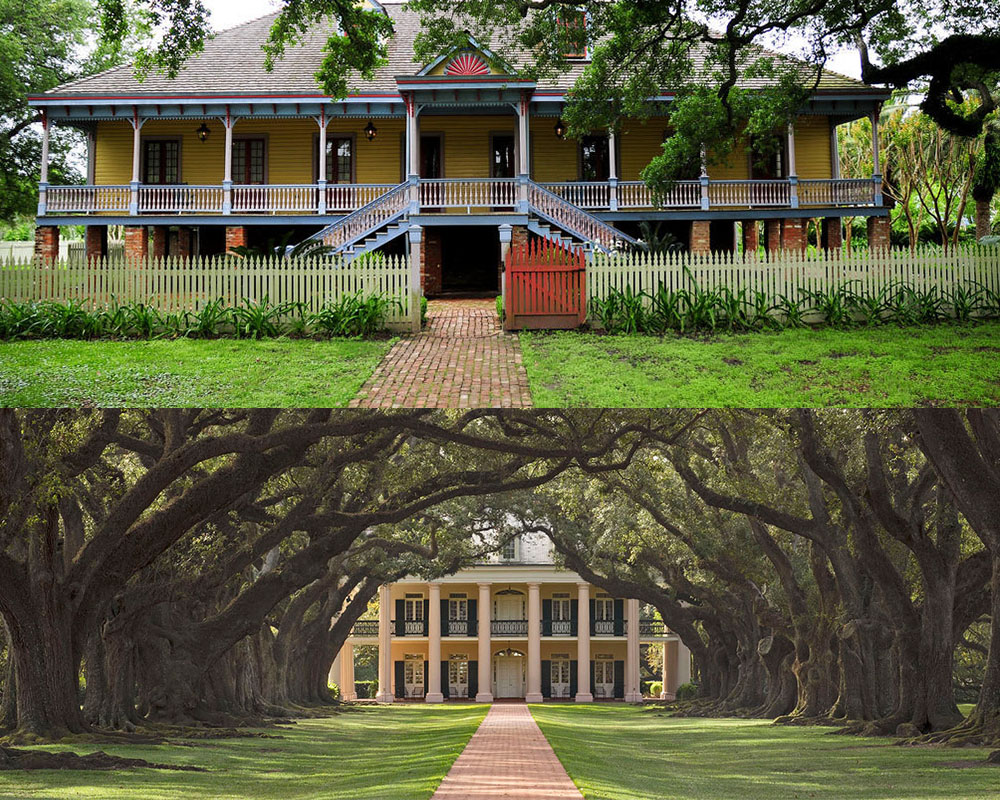

The word “plantation” was originally used for colonial expansion and then became more of what we know today as agricultural-based. When British colonists set foot in what is now Virginia, they divided the land into areas for farming. What is one of the differences between a farm and a plantation you may ask? Cash crops, which means the resources of the plantation are for commercial use as opposed to by the owner, which leads to a need for free labor to gain profit.
Today these plantations sit as museums encapsulated in time.
River Road’s Laura Plantation sits beneath Louisiana’s shady oak trees and has been there since its construction in 1804–1805. The locals fondly refer to it as the “big house.” The house includes a raised brick basement and an upper floor showcasing the intriguing briquette-entre-poteaux style. The architecture rates high in distinctiveness with it being one of only 30 substantial Créole-raised houses in the entire state. The inside is completed with Federal-style interior woodwork and an unexpected Norman roof truss.
As if this weren’t enough to make most visitors gasp in awe, we haven’t even gotten to the layout of this River Road plantation.
Picture two rows of five rooms, where each room seamlessly connects to the next. Inside the rooms are covered in antiques. Some of the areas have purposefully been unrestored, allowing visitors to view the nostalgic embrace of history and witness the intricate methods of wall construction.
When it comes to the history of Laura’s Plantation, it all begins in the 1700s, when a Colapissa village named Tabiscanja took note of the elevated terrain. This area was not only suitable for floods but also included a “long river view” of the Mississippi. As history unfolded, in 1785, the area became a home for Acadian refugees.
In 1804 Guillaume Duparc petitioned President Thomas Jefferson for the property, which was for sugarcane growth, it was extended to 12,000 acres by 1805. During the years before the civil war, The DuParc Plantation grew crops like indigo, rice, pecans, and sugar cane.
The plantation was used well into the 20th century and stopped being a plantation in the late 20th century when preservationist Norman Marmillion restored it and turned it into a tourist attraction.
Today you can visit this River Road plantation, which is now known as a Creole Heritage site.
The architecture of this River Road plantation is particularly special because it is one of Greek Revival designs. The mansion is built around a central hall that goes all the way from the front to the back of both floors. There are a total of 28 Doric columns that face the 28 oak trees in the alley which of course help give the plantation its name. The mansion is made up of bricks that were created on site and the walls are finished with stucco. Needless to say, this River Road plantation is an oak tree-loving, stucco house admiring historical architects’ dreams.
The history is sweet because the plantation was originally used to make sugar cane. French Creole Valcour Aime purchased the land in 1830 and was known as the king of sugar.
In 1836 Aimes’ brother-in-law, Jacques Télesphore Roman got ahold of the property by trading with a property he had. When Roman died in 1848, his wife Marie Therese Josephine Celina Pilié Roman took on the river road plantation. Rumor has it that Marie had quite the spending problem and in 1859, her son, Henry had to take over. Unfortunately, the apple didn’t fall too far from the (oak) tree. Henry found his way toward the throws of debt as well and ended up recovering his debt by giving the property to his family that loaned him money to auction off. This led to it being purchased by John Armstrong and as it’s all just a little bit of history repeating once again, Armstrong’s successors couldn’t afford the property either and by the 1920s, the River Road building became quite dilapidated.
In 1925, Andrew Stewart gifted his wife Josephine the property who then hired the architect Richard Koch to restore it. Unfortunately, in the 1900s, a virus wiped out the sugarcane industry, and the Stewarts used the River Road plantation as a cattle ranch. In 1972 the Oak Alley Foundation opened the plantation up to the public.
Not only can you visit the Oak Alley Plantation, but you can stay the night at one of their cottages and lean into the history.
Visiting one of these plantations can be a taxing process. When planning, consider Crescent City Tours your helping hand. Book with us for a stress-free adventure. Step into the past when visiting our many tour sites listed and create unforgettable memories of the future. We even do double plantation tours, and we can combine a plantation tour with a swamp tour.
Transportation to these sites can be tough for tourists, as there is no taxi or rideshare service in the small town that houses River Road plantations and many swamp tours – but with Crescent City Tours, we have you covered.